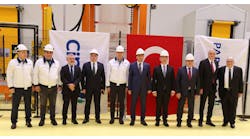"We improve continuity of service by anticipating failures with process and device diagnostics, which reduces downtime.” Schneider Electric’s Alain Ginguene explains the future-proofed capabilities of the EcoStruxure Foxboro DCS.
As its name implies, distributed control is all about going out into process applications and doing control. That’s all well and good, until it becomes apparent that the distributed control system (DCS) is being stretched across increasingly varied applications and widely scattered environments. Chief among the solutions taking on new roles to serve them is the EcoStruxure Foxboro DCS from Schneider Electric."EcoStruxure Foxboro DCS is a comprehensive portfolio of distributed control capabilities for powering the new digitalized economies," said Alain Ginguene, Schneider Electric’s director of global offer management for EcoStruxure Foxboro DCS. "These capabilities cover both capital-expenditure (CAPEX) and operational-expenditure (OPEX) projects, digital-twin simulation initiatives and Schneider Electric services, such as Flexible Execution (FLEX), Intelligent Power and Motor Control Center (iMPCC) and others."
Ginguene presented "Foxboro DCS Technical Outlook and Roadmap" during the opening keynote addresses on the first day of Foxboro User Group 2018 in San Antonio.
"Schneider Electric's approach to CAPEX and OPEX means we don't just ship a product one day, but instead get involved with users starting at the design stage, help them build and commission it, operate and maintain it throughout its full lifecycle, and eventually decommission it," explained Ginguene. "This is where the true value of a complete solution like EcoStruxure Foxboro DCS and all its tools come in."
On the CAPEX side where design and construction are the main goals, Schneider Electric's primary solutions come from the AVEVA software portfolio. However, as users and their projects move toward startup and operations, Schneider Electric's historian, process automation system (PAS), and planning and scheduling tools start to take the reins. The other part of this OPEX phase is maintenance, where users implement Schneider Electric's enterprise asset management (EAM) software.
"Because about 30% of work on projects is actually rework, we stress on both the CAPEX and OPEX sides identifying and doing only work that's useful," added Ginguene. "For instance, our vision for FLEX simplifies the steps in a project, but it also enables different participants to work in parallel, so they can finish more quickly and avoid a lot of former rework. This is possible because users can do cloud engineering and testing, intelligent enclosures, intelligent commissioning and digital hardware ordering all at the same time, which also means faster startups."
Likewise, iPMCC works with EcoStruxure Foxboro DCS to integrate electrical distribution, motor control and protection functions into intelligent and communicating architectures, according to Ginguene. "Integrating iPMCC and Foxboro DCS reduces CAPEX and improves project schedule control by using pre-engineered solutions, saves on integration costs, and shortens and secures the integration schedule," he said. "We improve continuity of service by anticipating failures with process and device diagnostics, which reduces downtime. We reduce OPEX costs with asset management aided with condition monitoring, and easy and fast device replacement. This also helps reduce energy, maintenance and technology evolution costs."
EcoStruxure Foxboro DCS and iPMCC also jointly enable process efficiency using a method similar to how the Internet of Things (IoT) operates, according to Ginguene. "We're also combining the cycle used to run physical assets with the cycle used for the digital-twin simulations into one loop, so they can serve as one global asset," he added. "This means users now get always-current updates about all the systems they need to run their plants."
Ginguene reported that Schneider Electric's vision for EcoStruxure Foxboro DCS is to have it deliver:
- Safe and secure operations by deploying a future-proof solution with reliable equipment and a continuously secure DCS;
- Early return on investment (ROI) at minimum cost and risk by using FLEX from design to running the plant;
- Value-focused Industrial IoT (IIoT) functions with help from plantwide integration of smart assets and analytics;
- Empowered workforces, which can use best-in-class HMIs with IIoT support for second-level support to improve plant performance, and safely run right up to capacity; and,
- Improved production value by employing patented, real-time accounting functions combined with Schneider Electric's Profit Advisor software.
"EcoStruxure Foxboro DCS is a future-proof DCS that consistently delivers measurable operation profitability improvements, and does it safely," said Ginguene. "Just like the IIoT, we're delivering the right information to the right people at the right time to make the best possible decisions."






